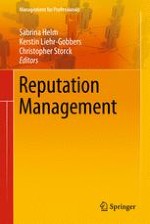2011 | OriginalPaper | Buchkapitel
Challenges in Measuring Corporate Reputation
verfasst von : Sabrina Helm, Christian Klode
Erschienen in: Reputation Management
Verlag: Springer Berlin Heidelberg
Aktivieren Sie unsere intelligente Suche, um passende Fachinhalte oder Patente zu finden.
Wählen Sie Textabschnitte aus um mit Künstlicher Intelligenz passenden Patente zu finden. powered by
Markieren Sie Textabschnitte, um KI-gestützt weitere passende Inhalte zu finden. powered by
